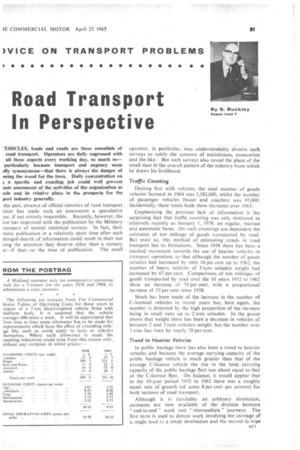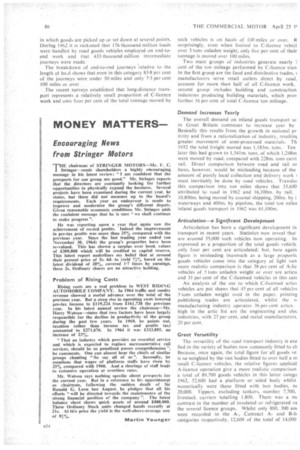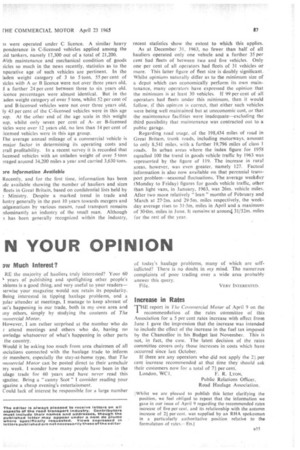Road Transport In Perspective
Page 87

Page 88

Page 89

If you've noticed an error in this article please click here to report it so we can fix it.
'EMCLES, loads and roads are three essentials of road transport. Operators are daily engrossed with all these aspects every working day, so much so— particularly because transport and urgency seem ally synonymous—that there is always the danger of eeing the wood for the trees. Daily concentration on a specific and exacting job could well prevent sate assessment of the activities of the organization as tole and its relative place in the prospects for the port industry generally.
the•past, absence of official statistics of road transport Ilion has made such an assessment a speculative 'Ise, if not entirely impossible. Recently, however, the ion has improved with the publication by the Ministry ranspoit of several statistical surveys. In fact, their :ssive publication in a relatively short time after such 'longed dearth of information could result in their not ving the attention they deserve other than a cursory !e---if that—at the time of publication. The small
operator, in particular, may understandably dismiss such surveys as solely the concern of statisticians, economist's and the like. But such surveys also reveal the place of the small man in the overall pattern of the industry from which he draws his livelihood.
Traffic Counting Dealing first with vehicles, the total number of goods vehicles licensed in 1964 was 1,582,000, whilst the number of passenger vehicles (buses and coaches) was 97,000. Incidentally, these totals both show increases over 1963.
Emphasizing the previous lack of information is the surprising fact that traffic counting was only instituted as 'relatively recently as January 1, 1958, on regular, manual and automatic bases. On such countings are dependent the estimates of ton mileage of goods transported by road. But even so, this method of estimating trends in road transport has its limitations. Since 1958 there has been a marked movement towards the use of heavier vehicles in transport operation, so that although the number of goods vehicles had increased by only 16 per cent up to 1962, the number of heavy vehicles of 3 tons unladen . weight had increased by 67 per cent. Comparisons of ton mileages of goods transported by road over the 10 years 1952 to 1962 show an increase of 79 per cent, with a proportional increase of 33 per cent since 1958.
Much has been made of the increase in the number of C-licensed vehicles in recent years but, here again, the number is distorted by the high proportion of the increase being in small vans up to 2 tons unladen. In the group above that weight there has been a decrease in vehicles of between 2 and 3 tons unladen weight, but the number over 3 tons has risen by nearly 70 per cent.
Trend to Heavier Vehicles In public haulage there has also been a trend to heavier vehicles and because the average carrying capacity of the public haulage vehicle is much greater than that of the average C-licence vehicle the rise in the total carrying capacity of the public haulage fleet was about equal to that of the C-licence fleet. On balance, it would appear that in the 10-year period 1952 to 1962 there was a roughly equal rate of growth (of some 8 per cent per annum) for both sections of road transport.
Although it is inevitably an arbitrary distinction, estimates are now available of the division between " end.to-end work and " intermediate" journeys. The first term is used to denote work involving the carriage of a single load to a single destination and the second to trips in which goods are picked up or set down at several points. During 1962 it is reckoned that 176 thousand million loads were handled by road goods vehicles employed on end-toend work and that 433 thousand million intermediate journeys were made.
The breakdown of end-to-end journeys relative to the length of haul shows that even in this category 83-8 per cent of the journeys were under 50 miles and only 7.3 per cent 100 miles oi over The recent surveys established that long-distance transport represents a relatively small proportion of C-licence work and only four per cent of the total tonnage moved by such vehicles is on hauls of 100 miles or over. R surprisingly, even when limited to C-licence vehicl over 3 tons unladen weight, only five per cent of their tonnage is moved over 100 miles.
Two main groups of industries generate nearly 1 cent of the ton mileage performed by C-licence trait In the first group are the food and distributive trades, r manufacturers serve retail outlets direct by road, account for more than half of all C-licence work. second group includes building and construction industries producing building materials, which prov further 16 per cent of total C-licence ton mileage.
Demand Increases Yearly
The overall demand on inland goods transport se. in Great Britain continues to increase year by Basically this results from the growth in national pr tivity and from a rationalization of industry, resultinj greater movement of semi-processed materials. Th 1952 the total-freight moved was 1,183m. tons. Ten later this had grown to 1,541m. tons, of which I.248m were moved by road, compared with 228m. tons earni rail. Direct comparison between road and rail or basis, however, would be misleading because of the amount of purely local collection and delivery work I must inevitably be done by road vehicles. Transfoi this comparison into ton miles shows that 33,600 attributed to road in 1962 and 16,100m. by rail., 10,800m. being moved by coastal shipping, 200m. by i waterways and 400m. by pipeline, the total ton milea inland goods transport in 1962 was 61,100m.
Articulation—a Significant Development Articulation has been a significant development in transport in recent years. Statistics now reveal that are around 55,000 such vehicles now operating. In expressed as a proportion of the total goods vehicle only four per cent are articulated; but, here again figure is misleading inasmuch as a large proportic goods vehicles come into the category of light van more realistic comparison is that 38 per cent of A-lie vehicles of 5 tons unladen weight or over are articu and 31 per cent of the C-licensed vehicles in this cat(
An analysis of the use to which C-licensed attici vehicles are put shows that 45 per cent of all vehicles 3 tons unladen weight used in the paper, printing publishing trades are articulated, whilst the rh manufacturing industry operates 36 per cent artics. high in the artic list are the engineering and elec industries, with 27 per cent, and metal manufacturers. 20 per cent.
Great Versatility
The versatility of the road transport industry is exe fled in the variety of bodies now commonly fitted to ch Because, once again, the total figure for all goods ye is so weighted by the van bodies fitted to over half a m small C-licence vehicles, the relative figures applicat A-licence operation give a more realistic comparison a total of 89,700 goods vehicles in this latter catego 1962, 52,600 had a platform or sided body whilst numerically were those fitted with box bodies, nk 20,000. Tippers, excluding tankers, number 7,700, livestock carriers totalling 1,800. There was a m; contrast in the number of insulated or refrigerated va the several licence groups. Whilst only 800, 300 am were recorded in the A-, Contract Aand B-1111 categories respectively,. 12,600 of the totalof 14,000 is were operated under C licence. A similar heavy ponderance in C-licensed vehicles applied among the Jid tankers, namely 17,300 out of a total of 21,200.
Nith maintenance and mechanical condition of goods licks so much in the news recently, statistics as to the nparative age of such vehicles are pertinent. In the laden weight category of 3 to 5 tons, 55 per cent of tides with A or B licence were not over three years old, I a further 24 per cent between three to six years old. icence percentages were almost identical. But in the aden weight category of over 5 tons, whilst 52 per cent of and 13-licensed vehicles were not over three years old, ly 43 per cent of the C-licensed vehicles were in this age iup. At the other end of the age scale in this weight )Up, whilst only seven per cent of Aor B-licensed tides were over 12 years old, no less than 14 per cent of icensed vehicles were in this age group.
rhe average annual mileage of a commercial vehicle is major factor in determining its operating costs and :rail profitability. In a recent survey it is recorded that Licensed vehicles with an unladen weight of over 5 tons !raged around 34,200 miles a year and carried 3,630 tons.
)re Information Available
Recently, and for the first time, information has been ide available showing the number of hauliers and sizes fleets in Great Britain, based on confidential lists held by
Ministry. Despite a marked trend in trade and lustry generally in the past 10 years towards mergers and algamations by various means, road transport remains !dominantly an industry of the small man. Although s has been generally recognized within the industry,
recent statistics show the extent to which this applies.
As at December 31, 1963, no fewer than half of all hauliers operated only one vehicle and a further 35 per cent had fleets of between two and five vehicles. Only one per cent of all operators had fleets of 31 vehicles or more. This latter figure of fleet size is doubly significant. Whilst opinions naturally differ as to the minimum size of a depot which can economically perform its own maintenance, many operators have expressed the opinion that the minimum is at least 30 vehicles, If 99 per cent of all operators had fleets under this minimum, then it would follow, if this opinion is correct, that either such vehicles were being well maintained but at uneconomic cost, or that the maintenance facilities were inadequate--excluding the third possibility that maintenance was contracted out to a public garage.
Regarding road usage, of the 198,454 miles of road in Great Britain, trunk roads, including motorways, amount to only 8,541 miles, with a further 19,796 miles of class 1 loads. In urban areas where the index figure for 1958 equalled 100 the trend in goods vehicle traffic by 1963 was represented by the figure of 119. The increase in rural areas, however, was even greater. namely 127. Factual information is also now available on that perennial transport problem—seasonal fluctuations, The average weekday (Monday to Friday) figures for goods vehicle traffic, other than light vans, in January, 1963, was 26m. vehicle miles. After two more relatively " lean " months of February and March at 27.2m. and 29-5m. miles respectively, the weekday average rises to 31-3m. miles in April and a maximum of 30-0m. miles in June. It remains-at aroun4 31/32m. miles for the rest of the year.




































































































































